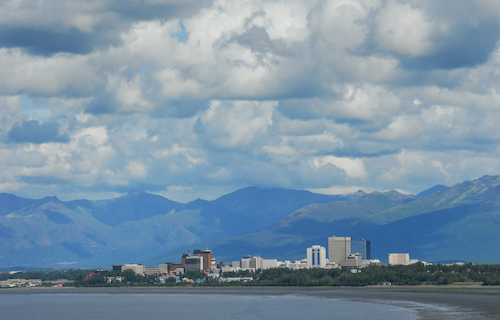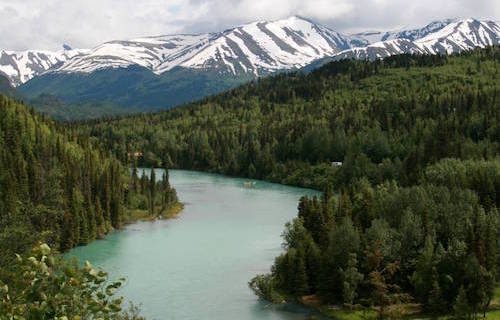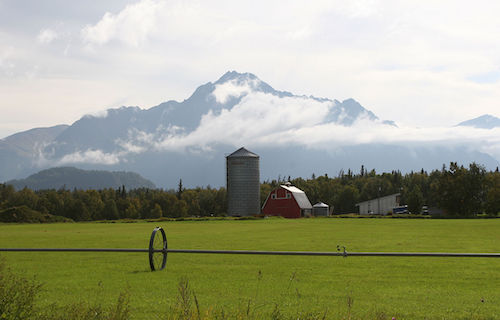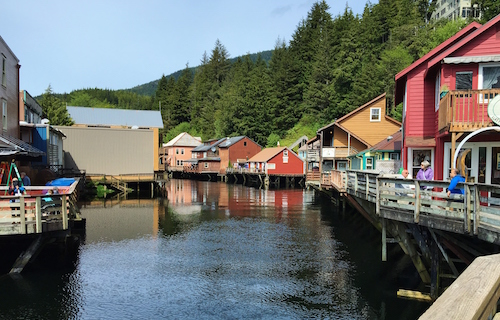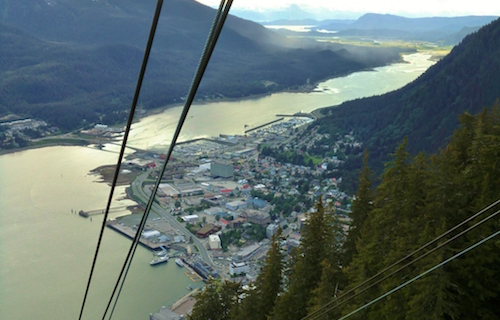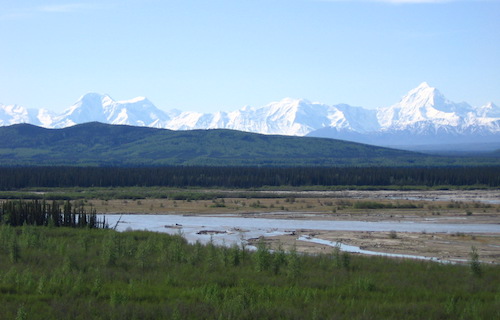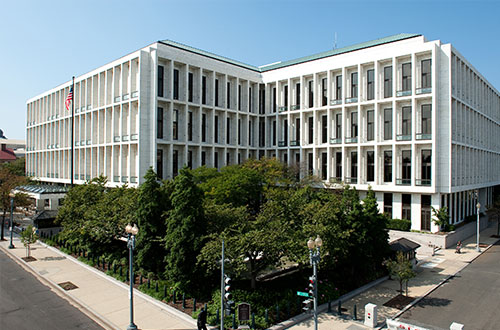Climate Change: An Alaskan Perspective
I have learned when talking about my home state of Alaska not to make the
assumption that “outsiders” actually understand the north. And I do not use
that term in a disparaging way. Alaska is far removed geographically from
the rest of the United States as well as mentally. So given that, let me give
some background with my apologies to those of you who are already
familiar with Alaska, the Great Land.
Alaska is nearly 600,000 square miles, which is one-fifth the size of the
Continental United States. If super-imposed over the Lower 48 states, it
would stretch from California to Florida. In addition to being a land of ice
and snow, we are home to North America’s largest rainforest. We have a
greater abundance of natural resources than any other state, ranging from the
largest coal deposits in the world to incredible fisheries. And Alaska has
one-fifth to one-third of the Nation’s coastline – depending on if you
measure at low or high tide.
More than one-fourth of the State lies above the Arctic Circle. The Arctic
region consists of a vast ocean surrounded by land, as opposed, of course, to
Antarctica which is a land continent surrounded by oceans.
For a majority of the year, Alaska’s Arctic is covered with ice and snow.
The land is frozen tundra which then gives way to the boreal forests that
encircle the globe. The Arctic region is teeming with wildlife for the short
summer when the sun never sets in the region. During the rest of the year,
most of the wildlife migrates south or hibernates. Even in the summer
months, though, the air temperature remains near freezing for most of the
time and severe summer storms can destroy habitat and cause wide swings
in animal populations.
The Arctic is also home to indigenous people who have lived off the land for
thousands of years. For the most part these people have continued to
practice a subsistence lifestyle, while also integrating modern technology
and convenience into their lives. In Alaska, the Arctic is home to the
Inupiaq people who are still active whalers, hunters and gatherers. The
Inupiaq also are savvy in the global economy and two of the state’s largest
and most successful private corporations are Inupiaq-owned.
The Arctic is the focus of extensive scientific study as it relates to climate
change. Scientists at the University of Alaska Fairbanks conduct extensive
research at facilities throughout the state and independent researchers from
other universities and institutes come from around the globe to study the
Arctic. The International Arctic Research Center at UAF, funded jointly by
United States and Japanese grants, was developed to create international
partnerships to study the role of the Arctic in climate change. Additionally,
the Barrow Geophysical Research Facility, being constructed in our nation’s
northern most community of Barrow, Alaska, will allow for information
sharing and support to climate scientists undertaking important research on
the role that oceans and sea ice play in impacting our climate. Just this past
week in Anchorage, we hosted yet another international conference on
climate change.
Why focus on the Arctic? Alaska has been called the “canary in the
coalmine” on the issue of climate change. Scientists focus in this area
because generally climate shifts are more severe at the poles and the changes
can be more readily apparent. In addition, scientists say that severe changes
to the Arctic could impact the rest of the globe and thus accelerate climate
changes in the future. Let me give you a couple examples. First, warming
in the Arctic could lead to a reduction in the ice pack and shorter periods of
snowcover. This could lead to even more warming as a significant reflector
of heat, white snow and ice, is replaced with dark oceans that absorb heat.
Second as permafrost melts it releases greenhouse gases held in the soil and
vegetation. Finally, if the icepack and glaciers melt they will release more
freshwater into the oceans which could possibly alter the ocean currents that
control regional climates.
So what are seeing in Alaska? Sometimes it is difficult to get a clear trend.
I was just in Fairbanks, our second largest city, last week where they
suffered through almost two weeks of temperatures at over forty degrees
below zero. While we read headlines in the Washington Post that this
January was one of the warmest on record, Fairbanks headlines declared the
opposite. They postponed the start of the Yukon Quest dogsled races
because it was too cold for even sled dogs, while schools remained open
except in extreme cold according to school district policies. Temperatures
on Friday, January 27 registered 51 below zero at 8 a.m., but even this did
not stop the buses from picking up kids.
On the other hand, many Fairbanksans remember fondly the hot
temperatures of the past summer when it was over 90 degrees for days on
end. Alaska is clearly a land of extremes when it comes to our climate.
In addition to the number of scientific studies conducted in the Arctic,
anecdotal evidence of change must also be considered. When I am visiting
the villages in the northern part of the state, speaking to elders, I ask them
about their experiences. They don’t speak about the Pacific Decadal
Oscillation, or attempt to debunk the now infamous hockey stick theory.
They tell me what they have personally observed over the years. Native
whaling captains tell me that the ice pack is less stable, and that there is
more open water requiring them to travel greater distances to hunt. The
snow pack is coming later and melting earlier than in years past. Salmon are
showing up in subsistence nets in greater numbers across the arctic.
Warmer, drier air, has allowed the voracious spruce bark beetle to migrate
north, moving through our forests in the south-central part of the state. At
last count, over three million acres of forest land has been devastated by the
beetle, providing dry fuel for outbreaks of enormous wild fires. To give you
some perspective, that is almost the size of Connecticut.
Scientific studies validate much of what Alaskans have observed. The
Arctic Council, comprised of the eight Arctic nations of Canada, Greenland,
Finland, Iceland, Norway, Russia, Sweden and the United States, worked to
produce the Arctic Climate Impact Assessment. The Assessment engaged
over 300 scientists and other experts to evaluate changes to the Arctic
climate. They estimate that average annual temperatures have risen between
two and three degrees Celsius in the Arctic over the past forty years, with
winter temperatures up almost four degrees. Additional studies document
changes to the ice pack that are forcing polar bears to swim greater distances
to find food, melting permafrost, receding glaciers, and a northern migration
of shrubs and wildlife.
After hearing me tell of the extreme cold temperatures felt by Alaskans
recently, you would think that Alaskans would want a little warming. There
is, however, a lot at stake in my home state if warming continues. It could
affect wildlife ranges and populations, which could impact both the
subsistence lifestyle of Alaskans and the commercial fisheries that are a vital
part of our economy. Warming could raise the threat of floods due to coastal
erosion as a reduction in sea ice allows for higher waves and storm surges
during the severe autumn storm season in the Arctic. Several villages are
already facing relocation and there is concern about their water source as the
sea water encroaches. A warmer winter negatively impacts the oil industry
along the North Slope. As exploration takes place in the winter when the
industry can easily transport drilling equipment by utilizing ice roads in
order to protect the tundra. If warming continues, the length of the
exploration season will be shortened. Thawing permafrost damages roads,
buildings and other infrastructure.
Climate change not only has impacts to the land but on the indigenous
people as well – changing their hunting patterns, diet and even their
language. For example I spoke with native whalers recently who told me
that they have now had to come up with a new word to describe the
crewmember that is stationed at the shore during the whaling season to
monitor ice conditions and alert the crew if it appears that the ice will
quickly retreat.
We know that changes are taking place to our climate. Whether it is
permanent or cyclical, however, remains a debate in the scientific
community. On one hand, you have some scientists proposing that nearly all of the recent
warming is due to human activity. Specifically, they say that by burning
fossil fuels and clearing forests, the concentration of carbon dioxide,
methane and other gases has increased in the atmosphere. These gases trap
heat in the atmosphere leading to increases in temperature. As evidence,
scientists point out that carbon dioxide concentration has increased by a third
since the industrial revolution and that the global temperature has increased
0.6 degrees Celsius.
On the other hand, there are some scientists that propose that much of the
changes in the earth’s climate are due to natural forces like solar output and
natural changes in ocean temperatures and currents. The climate is cyclical,
they say, and there is evidence that the earth underwent a similar warming
period known as the medieval warming period from around 1200 to 1350
AD. This was followed by a cooling trend known as the little ice age, which
continued until the beginning of the last century. These changes took place
despite the absence of human-produced greenhouse gases during a time
when evidence shows that CO2 levels remained relatively constant. They
explain the recent warming as simply the earth recovering from this recent
little ice age.
The Washington Post ran a front page article on Sunday January 29th about
abrupt climate change. According to scientists, 8,200 years ago, abrupt
change shut down the Atlantic conveyer belt and land temperatures in
Greenland dropped more than nine degress within two decades. Of course,
at the time, there were no manmade emissions.
On Capitol Hill there has been a recent shift in the debate on climate change.
For a long period of time it seemed the debate was about whether or not
climate change or global warming was real. You either believed in the
concept of human induced climate change or you didn’t.
As more and more information becomes available, I believe there is now
almost universal acceptance that our planet is warming. While the extent of
anthropogenic influence on our climate may remain in debate, I believe it is
a reality that man is contributing to the current warming trend. Accordingly,
it is appropriate – and quite frankly our responsibility – to take steps to curb
the growth of greenhouse gas emissions. We cannot afford to wait to take
action – while some warming can have positive impacts, such as opening
shipping lanes in the Arctic, significant warming of the planet will have
severe, negative impacts on our society.
We know we cannot control cyclical variables in our climate; we are at the
mercy of nature. We can, however, control and measure greenhouse gas
emissions from human activity. There are currently two policy approaches
being considered in Congress to accomplish emissions reductions. First, we
can regulate and mandate reductions in greenhouse gas emissions, chiefly
carbon dioxide from fossil fuel combustion, through cap and trade programs
where a low emitter can trade its excess emissions to high emitters. Second,
we can invest in research and technology to make a significant shift in the
way we produce and use energy.
Any policy we choose will have both costs and benefits. There have been
past attempts at carbon cap and trade programs in the United States to deal
with climate change and each has been rejected because the benefit of the
reduction in greenhouse gases did not justify the cost. The first major policy
Congress considered was the Kyoto Protocol. The National Center for
Atmospheric Research estimated that if Kyoto were implemented by all
industrial countries, the effect would avert only seven-hundredths of a
degree Celsius of global warming by 2050, and it would cost the economy,
as estimated by the U.S. Energy Information Administration, a reduction in
U.S. GDP of approximately $100 billion to $400 billion in 2010 alone. For
these reasons Kyoto was rightly dismissed unanimously by the United
States Senate.
Since then, proponents of the cap and trade approach have introduced less
aggressive, and therefore less costly, measures, from the McCain-Lieberman
Climate Stewardship Act, to the more recent approach promoted by the
National Commission on Energy Policy endorsed by Senator Jeff Bingaman.
Though I remain concerned about the costs versus the benefits of any cap
and trade program, as a member of the Senate Committee on Energy and
Natural Resources I look forward to spending time later this year
investigating this approach.
I believe that the United States can make a significant difference by
investing in new technologies that significantly change energy production
and consumption. I have supported the Administration’s investments in
climate science and technology, and I co-sponsored legislation drafted by
Senator Chuck Hagel that was included in the energy bill that passed
Congress last year which authorizes significant investments in the quest for
new technology to reduce carbon emissions – such as coal gasification, coal
liquefaction and clean-coal projects, carbon sequestration projects,
renewable energy projects, advanced nuclear power projects, low emission
transportation projects, and energy efficiency.
What we are currently doing is beginning to pay dividends, and, in fact, the
United States is showing greater progress than most of the nations that
signed on to Kyoto. In February 2002, the President committed the United
States to cut its greenhouse gas intensity, which is the amount emitted
compared to economic output, by 18 percent by 2012. The administration
did not mandate specific cuts, but instead allowed for innovation through
technology. Currently, we are on pace to meet our goals, and a recent
Energy Information Administration projection suggests doing so will reduce
carbon dioxide emissions by 366 million metric tons in the year 2012 alone.
On the other hand, economic reality is beginning to set in for most of the
countries of the world that signed onto the Kyoto Protocol. It is becoming
clear that the vast majority of the Nations will fail to meet their targets.
Tony Blair, a past vocal proponent of the Kyoto approach, last year
expressed serious doubt with the mandated approach to cutting emissions.
He acknowledged, “even if the US did sign up to Kyoto, it wouldn’t affect
the huge growth in energy consumption we see in India and China.” He
went on further to express support for, “the right market conditions to
increase the necessary investment to develop and install new low carbon
energy generation – and to ensure that it is shared with emerging
economies.”
I believe we have an obligation to help those less fortunate than us. By the
middle of the century, the world’s population will top 10 billion and almost
all of the growth will occur in the world’s poorest nations. These Nations
are beginning the process of developing economies and delivering the
services to their citizens that many of us take for granted. There are
currently two billion people without access to modern forms of energy. The
growing economies will clearly require new and abundant energy
generation. In the United States and throughout the developed world, we
have the economies and expertise to be able to help transitioning nations.
Doing so not only fulfills our duty to assist those in need, it can also help
improve our global environment.
The United States has joined Australia, China, India, Japan and South Korea
to form the Asia Pacific Partnership on Clean Development. The
partnership will help accelerate the development and deployment of existing
and emerging, energy technologies. Currently, China and India produce
twice as many emissions as the United States for each unit of GDP. There is
clearly room for improvement in existing power production. Additionally,
as developing nations build new capacity, they will have access to the
technology to install cleaner, more efficient power from the start.
Eventually, we will replace struggling economies, where residents who lack
food, shelter and sanitation are forced to choose survival over protection of
the environment, with growing economies that will have access to decades
of experience and innovation in energy production and efficiency at their
disposal.
Recognizing that human activity is a contributing factor to changes in
climate, the question is how to proceed with a solution that will work. I
believe it is critical for us to reach a consensus on how to move forward.
Our greatest progress will come by a cooperative global effort that combines
the best technologies and thinking to reduce greenhouse gases, helps
developing countries adopt new energy technologies and brings energy and
economic development to the countries with extreme poverty.
As I look out at the crowd I am mindful of my own time as a young law
student with bright ideas and aspirations. I am hopeful that some of you
become the leaders who will bring continued cooperation and effort to a
global solution to climate change. I thank you for the opportunity to speak
to you today.

